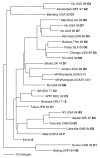New measles genotype, Uganda
- PMID: 16318690
- PMCID: PMC3366748
- DOI: 10.3201/eid1110.050431
New measles genotype, Uganda
Abstract
We report the first genetic characterization of wildtype measles viruses from Uganda. Thirty-six virus isolates from outbreaks in 6 districts were analyzed from 2000 to 2002. Analyses of sequences of the nucleoprotein (N) and hemagglutinin (H) genes showed that the Ugandan isolates were all closely related, and phylogenetic analysis indicated that these viruses were members of a unique group within clade D. Sequences of the Ugandan viruses were not closely related to any of the World Health Organization reference sequences representing the 22 currently recognized genotypes. The minimum nucleotide divergence between the Ugandan viruses and the most closely related reference strain, genotype D2, was 3.1% for the N gene and 2.6% for the H gene. Therefore, Ugandan viruses should be considered a new, proposed genotype (d10). This new sequence information will expand the utility of molecular epidemiologic techniques for describing measles transmission patterns in eastern Africa.
Figures



References
-
- Griffin DE. Measles. In: Knipe DM, Howley PM, editors. Fields virology. 4th ed. Philadelphia: Williams and Wilkins; 2001. p.140l–4l.
-
- World Health Organization. Measles mortality reduction and regional elimination strategic plan 2001–2005. Geneva: The Organization, 2001.
-
- Muller CP, Mulders MN. Molecular epidemiology in measles control. In: Leitner T, editor. The molecular epidemiology of human viruses. Amsterdam: Kluer Academic; 2002. p. 237–72.
Publication types
MeSH terms
Substances
Associated data
- Actions
- Actions
- Actions
- Actions
- Actions
- Actions
- Actions
- Actions
- Actions
- Actions
- Actions
- Actions
- Actions
- Actions
- Actions
- Actions
- Actions
- Actions
- Actions
- Actions
- Actions
- Actions
- Actions
- Actions
- Actions
- Actions
- Actions
- Actions
LinkOut - more resources
Full Text Sources
Medical
